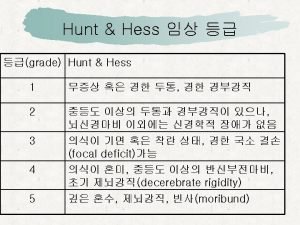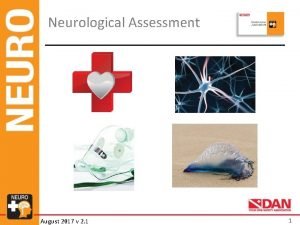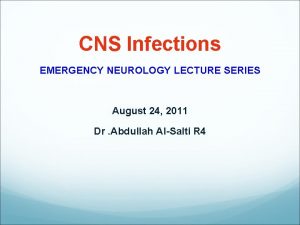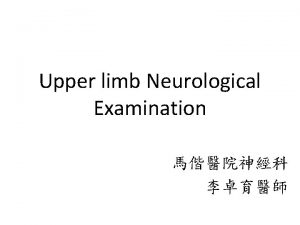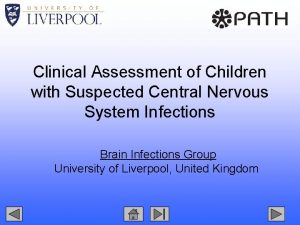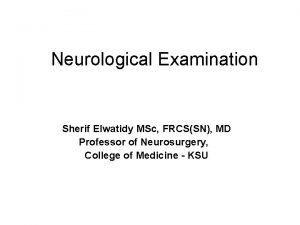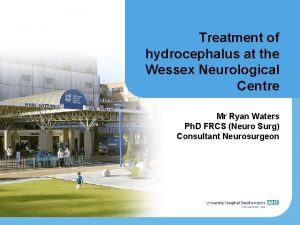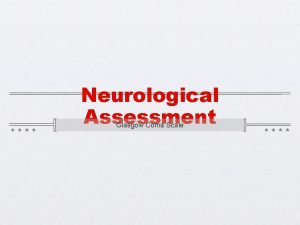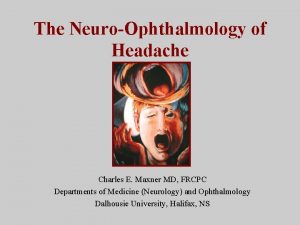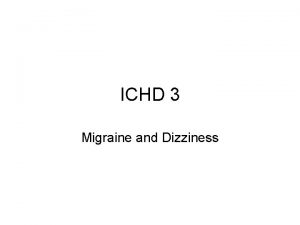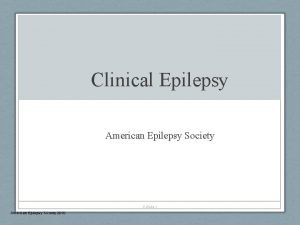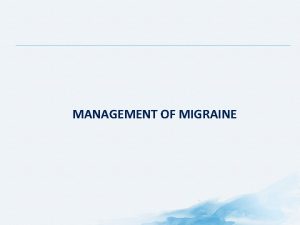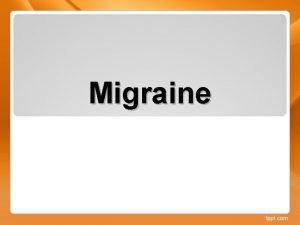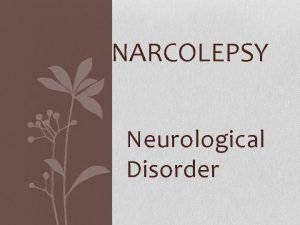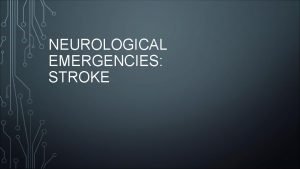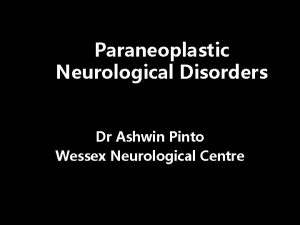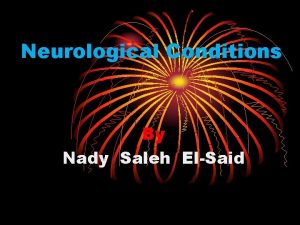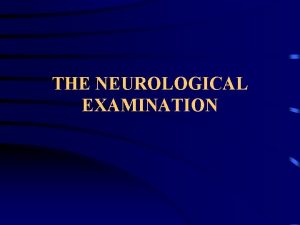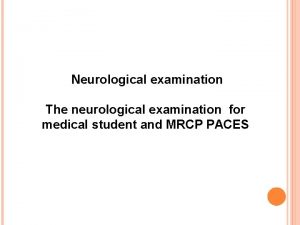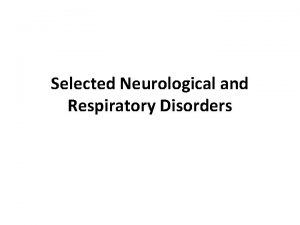YOUNGJO SONG Introduction Migraine Migraine is a neurological
























- Slides: 24

YOUNGJO SONG

Introduction - Migraine • Migraine is a neurological disease characterized by recurrent moderate to severe headaches often in association with a number of autonomic nervous system symptoms. • Associated symptoms may include nausea, vomiting, and sensitivity to light and sound. • It lasts for 2 -72 hours.

Introduction - Aura • An aura is a perceptual disturbance experienced by some with migraine before either the headache or seizure begins. • It often show as the perception of a strange light, an unpleasant smell or confusing thoughts or experiences.

Introduction - CSD • Cortical spreading depression(CSD) • Slowly propagating wave of rapid, near-complete depolarization of brain cells that lasts for about 1 minute and silences brain electrical activity for several minutes. • Depolarization • If the interior voltage of a cells becomes less negative than resting state, it called depolarization. • CSD is characterized by the collapse of ion homeostasis.

Introduction – Spreading depolarization • Abrupt, Near-complete sustained depolarization of neurons and massive redistribution of ions, and propagate at a similar rate to CSD. • In Spreading depolarization, restoration of the ionic gradients, repolarization, and recovery of brain function occur with a prolonged time course compared with CSD or do not occur at all. • Those depends on the degree of local metabolic compromise and impairment of (Na+K)ATPase activity.

Introduction – CSD vs. Spreading depolarization • CSD • Propagating depolarization that is followed by suppression of spontaneous activity and that is evoked in normally metabolizing brain tissue. • CSD causes no cell death or long-lasting damage in a normally metabolizing brain but imposes a considerable bioenergetics burden on tissue. • Spreading depolarization • All propagating depolarization that are induced within brain tissue with differing degrees of metabolic impairment and inhibition of neuronal and glial ATPases, and ranging from mild, CSD-like spreading depolarization to anoxic depolarization, which occurs when the metabolic impairment is near-complete. • In the injured brain, there is an eruption of spreading depolarization and these exacerbate tissue damage.

Phenomenology of CSD - CSD depolarization and associated ionic changes • V 0 : Extracellular potential • Vm: Membrane potential of a pyramidal cell. • CSD is a complex phenomenon that has different phases.

Phenomenology of CSD - CSD depolarization and associated ionic changes • Early phase : The apical dendrites are almost completely depolarized while the soma is only partially depolarized. • CSD-related depolarization is initiated by the activation of channels in apical dendrites. • Main phase : Both are completely depolarized. • Late phase : Only narrow-band in the dendrites remains completely depolarized. • This is followed by restricting net inward current to a narrow band in the apical dendrites.

Phenomenology of CSD – Cerebral blood flow and metabolic changes • ATP should be used to restore ionic gradients and to repolarize the membrane potential. • Because ATP is generated mainly in mitochondria by an oxygenutilizing process, oxygen consumption becomes high rate • Therefore a large transient increase in cerebral blood flow occurs when CSD happens. • The tissue partial pressure of O 2 may decrease to anoxic levels for up to 2 minutes after CSD in rodents.

Mechanisms – Initiation of CSD

Mechanisms – Initiation of CSD • Generation of a net self-sustaining inward current across the membrane is necessary to initiate the positive-feedback cycle. • The net inward current leads to membrane depolarization and the release of K+ into the restricted interstitial space. • This leads to further activation of voltage-gated and/or [K+] -dependent channels, further depolarization and an increase in local [K+]

Mechanisms – Initiation of CSD • This is the case of CSD induced by a brief K + pulse or by electrical stimulation. • Voltage-gated Ca 2+ channel(Cav 2. 1) activates, and Glutamate is released from cortical pyramidal cell synapses. • NMDAR activates and make further depolarization.

Mechanisms – Initiation of CSD • + sysmbols indicates the degree of blockade of CSD or spreading depolarization initiation, after complete pharmacological block. • ND : not determined. • ++++ : complete block

Mechanisms – Initiation of CSD • How to discover which element play important role in CSD. • NMDAR case • Put the pharmacological antagonist of NMDAR into brain. • Check whether NMDAR antagonist block CSD or not. • In the cerebral cortex and cortical slices, NMDAR antagonists completely block CSD even when the intensity of stimulation is several times larger than threshold. • We can suggest that NMDARs are necessary for CSD propagation.

Mechanisms - Propagation of CSD • The typical slow rate of CSD propagation implies that it is mediated by the diffusion of a chemical substance. • Mechanism • Flooding of K+ and glutamate into the extracellular space during CSD. • Both K+ and glutamate may mediate CSD propagation by diffusing into contiguous grey matter. • They initialize the positive-feedback cycle in adjacent cells. • Most evidence points to K+ rather than glutamate as the relevant diffusing substance.

Mechanisms-Initiation of spreading depolarization

Mechanisms-Initiation of spreading depolarization • In a brain slice, hypoxia or oxygen-glucose deprivation induce the anoxic depolarization, which is characterized by a rapid, complete neuronal depolarization. • During anoxic depolarization, the extracellular ionic changes are similar to ionic changes in CSD. • After anoxic depolarization initiation, the tissue is rapidly reoxygenerated to enable membrane repolarization and restoration of ion gradients.

Mechanisms-Initiation of spreading depolarization • Also, net self-sustaining inward current in the positivefeedback cycle needed to ignites anoxic depolarization. • This is mediated by multiple ion channels: NMDARs, Voltagegated Ca + /Na + channel(Cav, Nav), NSC(hypothetical nonspecific caton channels). • NMDARs are the key ion channels that mediate most rather than other ion channels.

Mechanisms-Initiation of spreading depolarization • + sysmbols indicates the degree of blockade of CSD or spreading depolarization initiation, after complete pharmacological block. • ND : not determined. • ++++ : complete block

Mechanisms – Sustained depolarization phase during CSD and spreading depolarization • Neuronal depolarization during CSD and Spreading depolarization is mainly maintained by Na+ influx through non-selective cationic channels. (The identity of this channel remains incompletely understood) • There is pharmacological evidence that activation of NMDARs contributes to the sustained depolarization phase of CSD and anoxic depolarization.

Implications – CSD arising in the migrainous brain • Migraine • Headache disorder with throbbing pain, nausea, vomiting and sensitivity to light and sound that lasts for 12 -72 hours. • Link between CSD and migraine. • The discovery that certain genetic mutations cause one type of migraine, increase the risk of migraine aura in humans and facilitate CSD in mouse models. • CSD activates the trigeminovascular system in animal models to cause headache. • Prophylactic drugs raise the electrical and KCl thresholds to evoke CSD as a mechanism of prevention.

Implications – Spreading depolarization arising in the injured brain. • When tissue is compromised, as in mild or severe ischaemia, spreading depolarization often contribute to lesion development. • Stroke most often arises from occlusion of a small or large cerebral vessel or from multiple small blood vessels, thereby depriving brain tissue of oxygen and glucose as well as effective waste removal. Stroke is accompanied by a massive release of glutamate as well as by ionic imbalances that contribute to excitotoxic events at the molecular and cellular level that participate in negative tissue outcome and probably the genesis of spreading depolarization. • Within the peri-infarct zone, spreading depolarization have been observed to cycle around the lesion’s outer margin and may provide a potential mechanism to enlarge focal ischaemic brain lesions.

Conclusion • Propagating depolarization is perpetrators of tissue injury within the compromised brain and in the genesis of migraine aura. • NMDARs are the key dendritic channels for CSD initiation. • Relationship of NMDARs and spreading depolarization is less clear. • It need to develop drugs that effectively target CSD or spreading depolarization initiation.

Thank You
 Wfns 1
Wfns 1 Pupil size assessment
Pupil size assessment Motor function neurological assessment
Motor function neurological assessment What is focal neurological signs
What is focal neurological signs Abnormal flexion vs extension
Abnormal flexion vs extension Is adhd a neurological disorder
Is adhd a neurological disorder Mrc muscle power
Mrc muscle power Physio rehab centre
Physio rehab centre Neurological based behavior
Neurological based behavior Neurological examination
Neurological examination Muscle power neurological examination
Muscle power neurological examination Ao classification system
Ao classification system Neurological considerations in language acquisition
Neurological considerations in language acquisition Biological trait theory criminology
Biological trait theory criminology Solent msk physiotherapy
Solent msk physiotherapy Papilloedema
Papilloedema Neurological disease
Neurological disease Uw neurological surgery
Uw neurological surgery Wessex neurological centre
Wessex neurological centre Glasgow coma scale video
Glasgow coma scale video Headache chart
Headache chart Migraine avec aura définition
Migraine avec aura définition Ichd 3 vestibular migraine
Ichd 3 vestibular migraine Ocular migraine
Ocular migraine Syncope vs seizure
Syncope vs seizure
